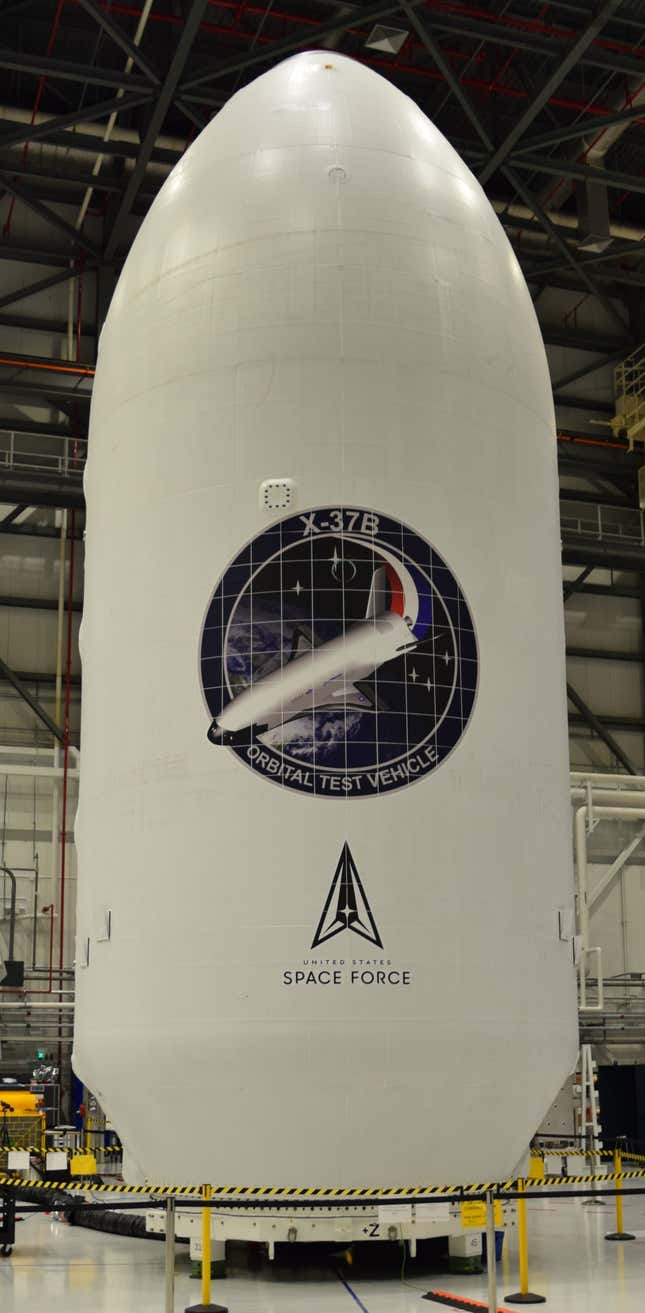How to Watch SpaceX Launch Space Force’s Spaceplane for the First Time
For the first time, a SpaceX Falcon Heavy will attempt to deliver the Pentagon’s spaceplane to low Earth orbit. The mission marks the seventh for the mysterious spacecraft, aiming to expand the Space Force’s knowledge of the space environment and test new technologies.
The Falcon Heavy is slated to launch at 8:15 p.m ET on Sunday, December 10 from launch complex 39A at Kennedy Space Center in Florida. Both side boosters will attempt vertical landings shortly after launch (Falcon Heavy is essentially three Falcon 9 rockets strapped together). The event will be livestreamed on SpaceX’s account on X, previously known as Twitter.
This will be a first for SpaceX—launching the spaceplane with a Falcon Heavy—having won the Air Force contract in 2018 through a competitive bidding process and snatching it away from United Launch Alliance’s Delta IV Heavy. This mission was supposed to get off the ground years ago but was delayed due to payload issues and launch window availability.
The USSF-52 mission will deliver the X-37B spaceplane, a project evolved from the earlier X-37A model developed by NASA in the late 1990s. Operated by the Air Force Rapid Capabilities Office and the U.S. Space Force, the uncrewed Boeing-built spaceplane is designed for reusability and is capable of atmospheric reentry and landing on traditional runways.
The mission “will expand the United States Space Force’s knowledge of the space environment by experimenting with future space domain awareness technologies,” Space Force said in a statement. “These tests are integral in ensuring safe, stable, and secure operations in space for all users of the domain.”
For its seventh mission, the X-37B will operate in new orbital alignments and carry a NASA experiment named Seeds-2. This experiment will expose plant seeds to the harsh radiation environment of long-duration spaceflight, gathering data vital for future crewed missions.
The spaceplane’s previous mission, launched atop a ULA Atlas V rocket in May 2020, saw the spaceplane spend a record 908 days in orbit before landing at NASA’s Kennedy Space Center in November 2022. This mission included a service module that expanded the spacecraft’s capabilities, and hosting more experiments than any previous missions. Among these were the Naval Research Laboratory’s Photovoltaic Radio-frequency Antenna Module experiment and two NASA experiments studying the effects of space conditions on various materials.
This upcoming mission marks SpaceX’s 92nd for the year 2023, inching closer to CEO Elon Musk’s ambitious target of 100 launches within the year. With several weeks remaining, the company appears to be on track to potentially reach this significant milestone.
For more spaceflight in your life, follow us on X (formerly Twitter) and bookmark Gizmodo’s dedicated Spaceflight page.
For the first time, a SpaceX Falcon Heavy will attempt to deliver the Pentagon’s spaceplane to low Earth orbit. The mission marks the seventh for the mysterious spacecraft, aiming to expand the Space Force’s knowledge of the space environment and test new technologies.
The Falcon Heavy is slated to launch at 8:15 p.m ET on Sunday, December 10 from launch complex 39A at Kennedy Space Center in Florida. Both side boosters will attempt vertical landings shortly after launch (Falcon Heavy is essentially three Falcon 9 rockets strapped together). The event will be livestreamed on SpaceX’s account on X, previously known as Twitter.

This will be a first for SpaceX—launching the spaceplane with a Falcon Heavy—having won the Air Force contract in 2018 through a competitive bidding process and snatching it away from United Launch Alliance’s Delta IV Heavy. This mission was supposed to get off the ground years ago but was delayed due to payload issues and launch window availability.
The USSF-52 mission will deliver the X-37B spaceplane, a project evolved from the earlier X-37A model developed by NASA in the late 1990s. Operated by the Air Force Rapid Capabilities Office and the U.S. Space Force, the uncrewed Boeing-built spaceplane is designed for reusability and is capable of atmospheric reentry and landing on traditional runways.
The mission “will expand the United States Space Force’s knowledge of the space environment by experimenting with future space domain awareness technologies,” Space Force said in a statement. “These tests are integral in ensuring safe, stable, and secure operations in space for all users of the domain.”
For its seventh mission, the X-37B will operate in new orbital alignments and carry a NASA experiment named Seeds-2. This experiment will expose plant seeds to the harsh radiation environment of long-duration spaceflight, gathering data vital for future crewed missions.
The spaceplane’s previous mission, launched atop a ULA Atlas V rocket in May 2020, saw the spaceplane spend a record 908 days in orbit before landing at NASA’s Kennedy Space Center in November 2022. This mission included a service module that expanded the spacecraft’s capabilities, and hosting more experiments than any previous missions. Among these were the Naval Research Laboratory’s Photovoltaic Radio-frequency Antenna Module experiment and two NASA experiments studying the effects of space conditions on various materials.
This upcoming mission marks SpaceX’s 92nd for the year 2023, inching closer to CEO Elon Musk’s ambitious target of 100 launches within the year. With several weeks remaining, the company appears to be on track to potentially reach this significant milestone.
For more spaceflight in your life, follow us on X (formerly Twitter) and bookmark Gizmodo’s dedicated Spaceflight page.
